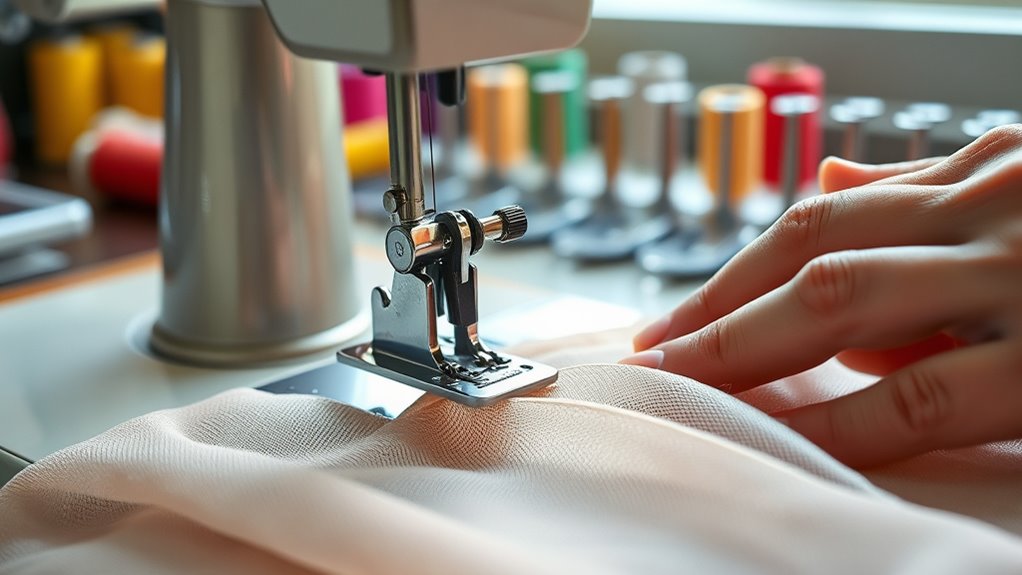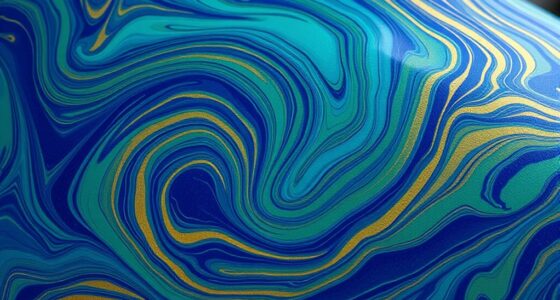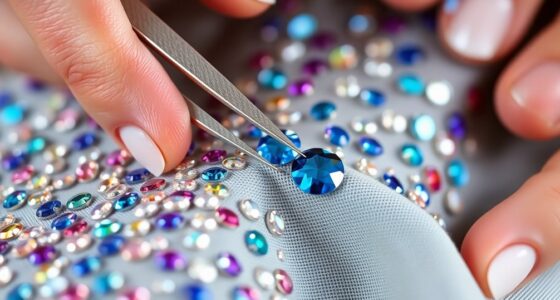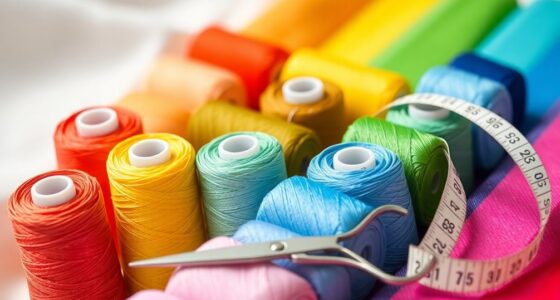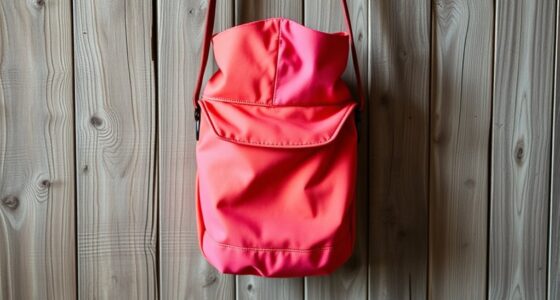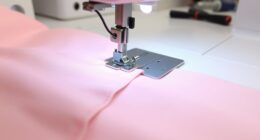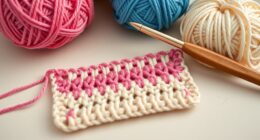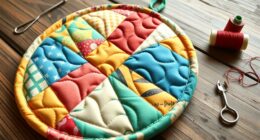When sewing tricky fabrics, pick a presser foot that provides extra fabric control, such as a walking or specialty stabilizer foot. Make sure your machine is compatible and consider features like non-stick surfaces or adjustable pressure to handle delicate or slippery materials. These feet help feed multiple layers evenly and prevent puckering. Using the right foot makes sewing smoother and the results cleaner. Keep exploring to discover more tips to master challenging textiles.
Key Takeaways
- Identify fabric type and select a compatible presser foot designed for delicate or slippery textiles.
- Use specialized feet like walking or Teflon to improve fabric control on tricky materials.
- Check machine compatibility before purchasing or attaching a presser foot to ensure proper fit.
- Consider adjustable pressure or built-in guides to enhance control over challenging fabrics.
- Opt for feet with stabilization features to prevent puckering, bunching, or shifting during sewing.

Selecting the right presser foot is essential for achieving professional-looking sewing results. When working with tricky fabrics, the right presser foot can make all the difference in ensuring smooth sewing and a polished finish. One of the critical factors to contemplate is how your chosen presser foot helps with fabric stabilization. Certain fabrics, like silk or chiffon, tend to slip or shift easily under the needle, making it challenging to sew straight or neat seams. Special presser feet, such as walking feet or dual-feed feet, are designed to provide better fabric stabilization by feeding multiple layers evenly through the machine. This reduces puckering and bunching, giving you cleaner stitches and more precise seam allowances.
Choosing the right presser foot ensures smooth sewing and precise seams on tricky fabrics.
Another vital consideration is sewing machine compatibility. Not all presser feet fit every machine, so you need to check whether the foot you’re considering is compatible with your specific model. Some sewing machines use snap-on feet, while others require screw-on types. Many modern machines have standards or adapters, but it’s always best to verify before purchasing. Using a presser foot that isn’t compatible can lead to poor stitching, damage to the machine, or the foot simply won’t attach properly. Be sure to consult your sewing machine manual or manufacturer’s website for compatibility details, especially when working with specialized presser feet for tricky fabrics.
When choosing a presser foot for challenging textiles, think about the features that will help stabilize your fabric. For example, a walking foot is excellent for quilting and handling multiple layers, providing even feed and reducing shifting. A Teflon or non-stick foot can be beneficial for sticky or delicate fabrics like vinyl or leather, preventing sticking and bunching. For fabrics prone to slipping, a roller or adjustable guide foot can help maintain consistent seam allowances. These feet work together with your sewing machine’s features to give you better control over tricky fabrics.
Additionally, considering the availability of specialized presser feet designed specifically for delicate or difficult materials can significantly improve your sewing experience. These specialized feet often incorporate features that assist in managing challenging fabrics more effectively.
Beyond stability, consider how easy it is to use and adjust the presser foot on your machine. Some presser feet come with adjustable pressure settings, which can be useful when sewing delicate fabrics. Also, look for features that facilitate fabric feeding, such as built-in guides or textured surfaces. The right presser foot not only improves fabric stabilization but also enhances overall sewing accuracy and quality. Remember, selecting a presser foot tailored to your fabric type and compatible with your machine will save you time, frustration, and produce more professional results on your tricky fabrics.
Frequently Asked Questions
Can I Use a Universal Presser Foot on All Tricky Fabrics?
You might wonder if a universal presser foot can handle all tricky fabrics. While it offers some versatility, universal foot limitations mean it may not perfectly suit every fabric. Some materials, like delicate or thick fabrics, require specialized presser feet for better fabric compatibility. To achieve the best results and avoid damage, it’s smart to switch to specific presser feet designed for challenging textiles instead of relying solely on a universal one.
How Do I Prevent Fabric From Slipping Under the Presser Foot?
To prevent fabric from slipping under the presser foot, you should focus on fabric gripping and tension adjustment. Use a presser foot with better grip or add a non-slip grip pad if needed. Also, adjust your machine’s tension to match the fabric type, ensuring it’s not too loose. These steps help keep your fabric steady, making your stitches more accurate and your sewing experience smoother.
Are Specialized Presser Feet Compatible With All Sewing Machine Brands?
Specialized presser feet aren’t universally compatible with all sewing machine brands. You need to verify presser foot compatibility before buying, as many brand-specific presser feet work only with their own machines. Always verify if the presser foot is compatible with your machine model and brand. Using brand-specific presser feet ensures proper fit and function, helping you achieve the best sewing results without damaging your machine.
How Do I Clean or Maintain Delicate Presser Feet?
To keep your delicate presser foot in top shape, clean it regularly with a soft brush or mild soap and water, avoiding harsh chemicals. Proper fabric care means wiping away lint and thread buildup, which helps maintain presser foot longevity. Store it in a dry, dust-free place when not in use, and handle gently to prevent damage. Regular cleaning guarantees smooth sewing and extends the life of your presser foot.
Can Using the Wrong Presser Foot Cause Damage to My Fabric?
Using the wrong presser foot can definitely cause fabric damage, especially if it’s not compatible with your fabric type. When presser foot compatibility isn’t considered, it might pull, snag, or stretch delicate fabrics, leading to permanent damage. To avoid this, always select a presser foot suited for your fabric, ensuring smooth sewing. Proper presser foot choice helps protect your fabric and results in a clean, professional finish.
Conclusion
Now that you know how to select the perfect presser foot for tricky fabrics, you’re equipped to navigate any sewing challenge that comes your way. Think of your presser foot as a trusted partner, guiding your stitches smoothly through even the most stubborn textiles. With a little practice and the right tools in hand, you’ll turn sewing hurdles into seamless victories—like a captain steering through stormy seas toward calm waters. Happy sewing!
